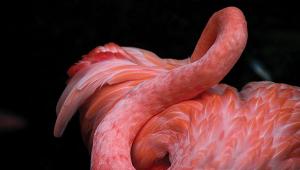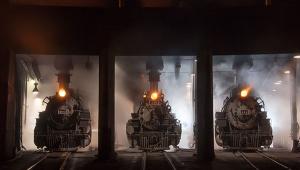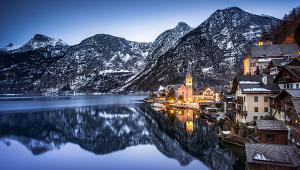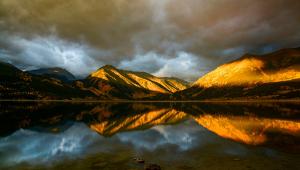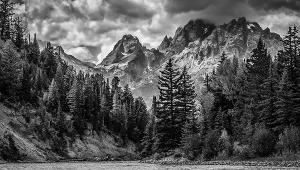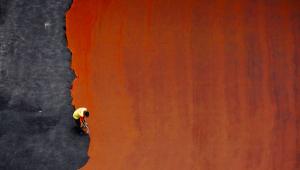Super Deep Depth Of Field

Glenn Mieritz got sharp focus from the spokes on the nearest bike to the fender on the farthest near Notre Dame in Paris, plus included the striped line to reinforce the visual effect. Surprisingly, he encompassed all with an aperture of f/4, although using an 85mm focal length and stepping back did the trick. He shot with a Nikon Coolpix P7100; shutter speed was 1/60 sec and he converted to black and white with Nik’s Silver Efex Pro 2.
© Glenn Mieritz
Our Picture This! assignment this month was Super Deep Depth of Field and readers responded with urban, nature, and landscape images that made great use of this creative technique. Depth Of Field (DOF)—the relationship of foreground to background focus in an image—is determined by three factors: lens focal length, camera to foreground subject distance, and aperture. Some readers used a variety of combinations of the big three to come up with some startling images, stills that the unaided eye cannot encompass in one “blink.” Others bypassed many of the classic techniques and relied on software to do the trick.

Park, NY
Gary Paige visited this idyllic spot in upstate New York in the autumn and came away with this deep DOF shot encompassing flow and sharpness from the stream bank in the foreground to the feeder falls in the background. He worked with a Nikon D3S and a Nikkor 24-70mm f/2.8 lens. Exposure was f/22 at 1.6 seconds.
© Gary Paige

A blend of two shots—one exposed and focused on the foreground and likewise on the background on the second—shows all is fair in the search for deep DOF. Susan Taylor exposed both with a Canon EOS 5D Mark III and a Canon 24-70mm f/2.8 lens atop a Really Right Stuff tripod.
© Susan Taylor
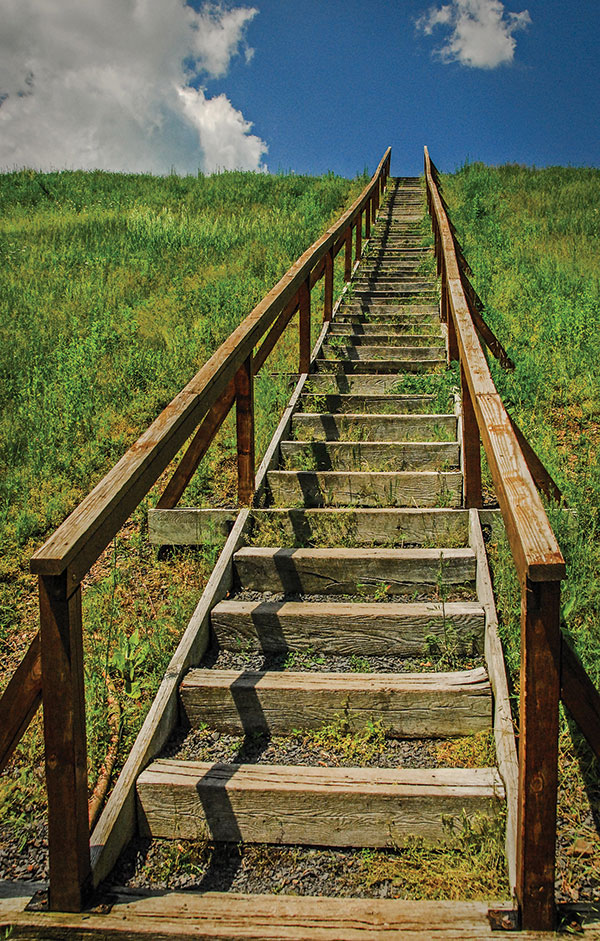
George Shearer made this photo of a set of steps up to the lake in Little Buffalo State Park, Pennsylvania. The photo was made with a Nikon D80 and an AF-S DX Nikkor 18-200mm f/3.5-5.6G ED lens. Exposure was f/8 at 1/800 sec and ISO 800. He set his focal length at 20mm and worked in Aperture Priority mode.
© George Shearer

Sharp Todd exposed 10 shots, starting with the closest part and then moving focus through the scene. He then processed the files in Helicon Focus software, which finds the sharp parts of each file and merges them together to create one new file. He then edited the file in Photoshop CS, adjusting levels and saturation, and finally added some sharpening with the Unsharp Mask filter. To top it off, he flipped the image horizontally to improve the composition. He used a Nikon D300 with a Nikkor 105mm f/2.8 AF macro lens atop a Manfrotto tripod and exposed at f/16 at 1/30 sec for all the shots.
© Sharp Todd

Douglas Croft wrote: “The harbor is so picturesque it just begged for that photo to be taken.” He worked with a Nikon Coolpix P7100 at 28mm (equivalent) and an exposure of f/4 at 1/1000 sec. He added a touch of contrast and saturation and opened the shadows a bit in post.
© Douglas Croft

Maurice A. Mufson, M.D., made this photo looking down from nearly the top of the staircase during a visit to the lighthouse in St. Augustine, Florida. Exposure with a Canon PowerShot G16 was f/1.8 at 1/30 sec with a 24mm focal length setting, proving that employing a wide focal length and the right point of view can get you a deep DOF, even at a very wide aperture.
© Maurice A. Mufson, M.D.

Dan Wampler made this photo of the St. Louis Gateway Arch using a Canon EOS 50D converted to infrared at 590nm and a Tamron SP AF 10-24mm f/3.5-4.5 Di II LD Aspherical lens. He made three exposures (1/60 sec, 1/125 sec, 1/250 sec) at f/11. He notes: “The red and blue channels were swapped.”
© Dan Wampler

Larry Lanius II shows us the clear and sharp path in this photo of the Tyngsborough Bridge in Massachusetts. He shot three exposures with his Canon EOS 7D and Tamron 10-24mm lens at 20mm and f/16 and combined them in Nik’s HDR Efex Pro 2.
© Larry Lanius II

Nick Van Zanten made this photo at Pictured Rocks National Lakeshore on the shore of Lake Superior in the Michigan Upper Peninsula. The slanting rays in the foreground all lead the eye right to the sun. Exposure with a Nikon D300 and a Nikkor 18-200mm lens was f/22 at 1/80 sec.
© Nick Van Zanten
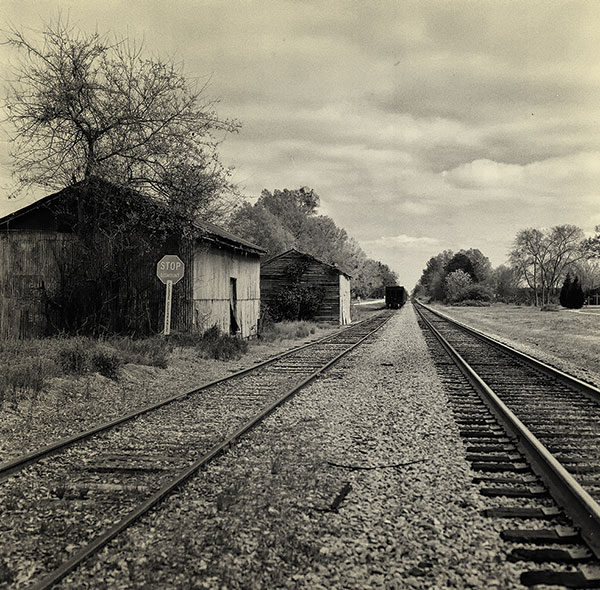
Pete Purvis made this photo of “railroad tracks leaving a rural South Carolina area once a hub for the now dead textile industry.” He worked with a Hasselblad 500C/M and an 80mm lens and shot on Ilford HP5 with an exposure of f/16 at 1/60 sec.
© Pete Purvis

Joe Fred Vasquez Jr. took this photo from Interstate Highway 35 near Longhorn Stadium in Austin, Texas. Exposure with a Canon EOS 5D Mark II and a 17-40mm lens (at 17mm) was f/4 at 8 seconds.
© Joe Fred Vasquez Jr.
Picture This! – Our Next Assignment
Red!
For our next Picture This! assignment we are looking for images whose predominant color is red, or where a red accent makes a bold statement within the frame. Perhaps the boldest color, red always catches the eye. Other colors are welcome of course, but think of using complements and supplements and those that enhance the presence of red within the frame.
Note: Be sure to include your name in the information box so we may properly copyright should we choose your image for the Picture This! assignment.

© George Schaub
How To Submit Online
1. Go to www.shutterbug.com and register. Scroll down the page and on the right side you will see a box for entering your username and your password. If you have already registered and/or submitted images for the Galleries you can skip this step. Respond to the activation e-mail. Registration is free. You will use your username and password whenever you visit or, with some systems, it will automatically load for you when you visit www.shutterbug.com.
2. Check the assignment and closing dates in the magazine. When the magazine is printed we will create an appropriate gallery for your images. The limit is two images per assignment.
3. Select and prepare your images. We only accept files at a maximum 5MB size, JPEG format. Save the JPEG at a quality level of 10 or higher. Note that file size in your image folder directory will determine upload size, not the “opened” file size, as JPEG compresses at 1:4 at higher quality ratings. If your images do not load it probably means you have exceeded the file size or have not used JPEG format.
4. Click on the Galleries tab on the homepage. In the Category section use the drop-down menu to select the Picture This! assignment. Note that images are simultaneously loaded into the assignment category as well as your own personal gallery. When the Picture This! assignment deadline date has lapsed the assignment gallery will be removed, but your images will still reside in your own gallery.
5. In the Description box add title, camera, lens, exposure information, and your full name. Also add any other comments or anecdotes you think relevant. We reserve the right to edit comments as needed.
6. Click the Save button at the bottom of the page. This uploads the image.
7. You retain copyright on the image.
8. We will choose the images after close of the due date.
9. Please feel free to comment on images submitted by other readers.
Scorecard
Deadline For Submission: September 15, 2014.
Images will appear in our December 2014 issue.
Our Next Topic: Backlight
Deadline For Submission: October 15, 2014
Publlication Date: January 2015 issue
Please Note: By submitting you agree to give us the right to show the image(s) on the web and for publication. You give us publication rights in the magazine and on the website(s) of Source Interlink Media.
Please Note: If you submit images with an enhancement through software beyond contrast, exposure, and simple saturation adjustments please indicate the software and “filter” used to attain that effect.—Editor
Want to see images selected for past picture this! Assignments? Go to www.shutterbug.com and click on picture this! In the “more articles…” box on the homepage.
Please Note: If the photograph includes a minor or a recognizable individual or group you are guaranteeing that you have a signed model release form, and especially a parental or guardian release form for minors. You should keep a copy of that release in your files. Scan that release and keep it handy. If an image is chosen for publication, failure to provide a form when requested will eliminate the image from consideration. You can find release forms at http://asmp.org/tutorials/model-release-minor-child.html and other resources on the Internet. By uploading images you attest that the model release form is valid, that any depiction of a person is with their consent, that you have a model release form available on request, and that all images you submit have been made by you.
If you have any questions or problems e-mail us at editorial@shutterbug.com with Picture This! in the subject line.
- Log in or register to post comments
